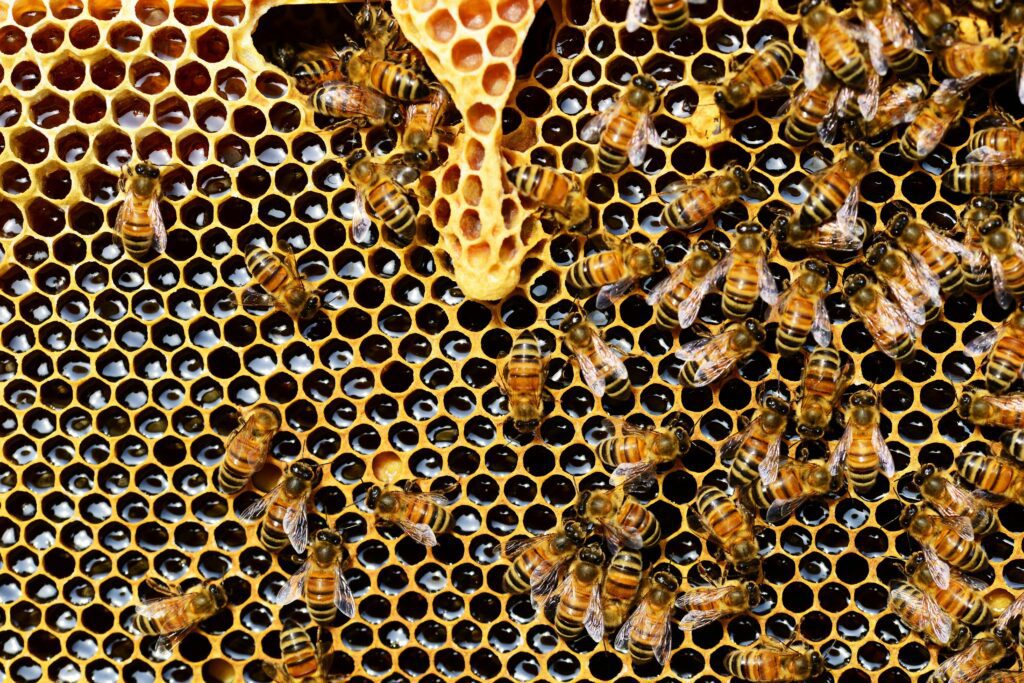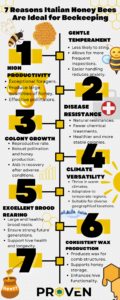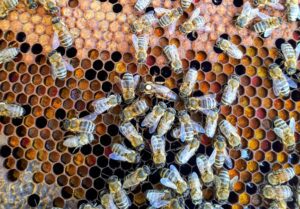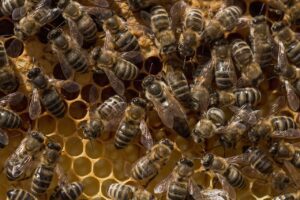Understanding the life stages of development in honey bees is crucial for beekeepers to ensure the health and productivity of their colonies. From the egg stage to adult emergence, each phase plays a vital role in the hive’s ecosystem. Beekeepers actively monitor these stages, from egg incubation to pupal metamorphosis, to safeguard against diseases and ensure optimal conditions for growth. This article explores these developmental stages in detail, emphasizing the pivotal role of beekeepers in maintaining colony vitality and sustainability.
Table of Contents

If you are just starting out, check out Beginner’s Guide to Beekeeping: 8 Steps for Starting Your Journey.
1. Egg Stage
Egg Laying Process
- Egg Production: The queen bee lays eggs individually into the bottom of the wax cells within the hive.
- Egg Size: Each egg is tiny, approximately 1.2 mm in length and cylindrical in shape.
- Quantity: A queen bee can lay up to 2,000 eggs per day during peak season.
- Development Time: Eggs typically hatch within 3 days after being laid.
Egg Characteristics
- Appearance: Honey bee eggs are pearly white and initially upright but gradually tilt as they age.
- Adaptation: The eggs are adapted to withstand varying hive conditions, such as temperature fluctuations.
Importance in Colony Growth
- Foundation: Eggs serve as the foundation for the hive’s population growth and sustainability.
- Role in Development: They are crucial for replenishing the colony and ensuring continuous worker, drone, and queen production.
2. Larval Stage
Larval Development
- Egg Hatching: When the egg hatches, it releases a small, legless larva.
- Feeding: Nurse bees feed the larvae royal jelly for the first few days, which is rich in proteins and essential nutrients. Later, they switch to worker jelly.
- Growth: Larvae grow rapidly, increasing in size significantly within the span of a few days.
- Cocoon Formation: Towards the end of the larval stage, larvae spin themselves into silk cocoons.
Characteristics
- Appearance: Initially, larvae are small, white, and curled at the bottom of their cells. They gradually grow and stretch out as they develop.
- Development Time: The larval stage lasts approximately 6 days.
- Behavior: Larvae are largely immobile and depend entirely on nurse bees for food and care.
Importance to Colony
- Future Bees: Larvae represent the future worker bees, drones, and potential future queens.
- Nutrient Source: Primarily royal jelly during the initial stages. Royal jelly is a protein-rich secretion produced by worker bees from their hypopharyngeal glands. It provides essential nutrients such as proteins, lipids, vitamins, and hormones that are crucial for the rapid growth and development of honey bee larvae. As the larvae mature and transition to older stages, they are fed a mixture of royal jelly and worker jelly, which consists of honey, pollen, and glandular secretions from nurse bees. This diet variation supports their nutritional needs through the different developmental stages.
3. Pupal Stage
Pupal Stage Development
- Metamorphosis Begins: After the larval stage, the larva spins a silk cocoon around itself and undergoes metamorphosis. This transformation is a critical phase in the life cycle of a honey bee, marking the transition from larva to pupa. Inside the cocoon, profound changes occur as the larva’s body undergoes restructuring to form the adult bee. Metamorphosis involves the breakdown of larval tissues and the development of adult structures, including wings, legs, eyes, and antennae. This process typically takes place within a sealed cell of the hive, ensuring the pupa’s protection and allowing for uninterrupted development.
- Structural Development: During this stage of honey bee development, the pupa undergoes structural development, transitioning from a formless mass to a fully formed adult bee. Within the protective confines of its wax-sealed cell, the pupa’s body undergoes intricate changes. It develops distinct features such as wings, legs with specialized pollen baskets, compound eyes for optimal vision, and a proboscis for feeding on nectar. This developmental phase is crucial for the bee’s future role in the colony, preparing it to fulfill tasks ranging from foraging to hive maintenance.
- Cell Sealing: After a honey bee larva completes its growth and pupates, worker bees cap the cell with wax to seal it. This sealing process is vital for protecting the developing pupa during its transformation into an adult bee. The sealed cell provides insulation and security, shielding the pupa from potential threats such as predators and environmental changes. This phase marks the culmination of the bee’s metamorphosis, ensuring that the newly developed adult bee emerges under optimal conditions to contribute effectively to the colony’s welfare and productivity.
Characteristics
- Transformation: This stage involves significant changes as the larval body transforms into an adult bee.
- Color Change: Initially, the pupae are white, but they gradually darken as they develop.
- Duration: The pupal stage typically lasts about 12 days for worker bees, varying slightly depending on environmental conditions.
Importance to Colony
- Adult Emergence: The emergence of adult honey bees from pupae replenishes the colony’s workforce.
- Behavioral Development: During the behavioral development stage, honey bees undergo crucial processes that equip them with the instincts and skills essential for their roles within the colony:
- Foraging Instincts: Bees develop a strong innate drive to forage for nectar, pollen, water, and propolis. This instinct is vital for sustaining the colony’s nutrition and ensuring the production of honey and food reserves. Modern Honey Production: 12 Proven Methods to Boost Output
- Communication Skills: Bees learn and develop complex communication behaviors, such as the famous waggle dance. This dance communicates the location of food sources and other important resources to other colony members, enabling efficient resource gathering.
- Nesting and Hive Maintenance: Bees acquire skills related to nest construction, comb building, and hive maintenance tasks. They learn how to regulate hive temperature and humidity, protect the colony from predators, and keep the hive clean and organized.
- Social Interaction: Behavioral development includes learning social interactions within the colony hierarchy. Bees understand their roles as workers, drones, or queens, and they interact accordingly to maintain colony cohesion and productivity.
- Defense Mechanisms: Bees develop defensive behaviors to protect the colony from threats such as predators and invaders. They learn to identify and respond to potential dangers, including predatory insects and animals, as well as diseases that could threaten the colony’s health.
- Environmental Adaptation: Bees adapt their behaviors to environmental conditions, such as changes in weather and availability of resources. They learn to adjust foraging patterns and resource management strategies based on seasonal variations and the colony’s needs.
- Learning and Memory: Bees demonstrate learning capabilities and memory retention, enabling them to remember profitable foraging sites, navigate complex environments, and adapt to changes in their surroundings.
- During this stage, bees undergo continuous learning and adaptation, honing their skills and behaviors to ensure the survival and success of the colony. This behavioral development is essential for the efficient functioning and resilience of honey bee colonies in diverse environmental conditions.
- Genetic Diversity: Pupae represent the genetic diversity of the hive, influenced by the queen’s mating with multiple drones.
4. Adult Worker Honey Bees
Adult Emergence
- Breaking the Cell: Adult bees chew their way out of the capped cell where they developed as pupae.
- Timing and Conditions: Emergence typically occurs when environmental conditions are favorable, such as during warm temperatures.
- First Tasks: Upon emerging, bees start their roles immediately, with some heading straight to hive duties and others venturing out for foraging.
Life After Emergence
- Orientation Flights: Newly emerged bees undertake short flights around the hive to familiarize themselves with surroundings.
- Early Roles: Young honey bees often start with tasks like cleaning cells, feeding larvae, or assisting in hive temperature regulation.
- Young Worker Bees (1-2 weeks old): Upon emergence, young worker bees start by cleaning cells and assisting in hive temperature regulation.
- Nurse Bees (1-2 weeks old): These worker bees also serve as nurse bees, feeding larvae and producing royal jelly to nourish developing brood.
- Age-based Tasks: As honey bees age, they progress to more complex duties like guarding the hive entrance or foraging for nectar and pollen.
- Guard Bees (2-3 weeks old):
- Guarding the hive entrance against intruders and predators.
- Maintaining hive security and defending against threats.
- Forager Bees (3 weeks old and older):
- Collecting nectar and pollen from flowers in the surrounding area.
- Communicating food source locations to other bees through the waggle dance.
- Guard Bees (2-3 weeks old):
Role in Colony
- Colony Dynamics: The emergence of adult honey bees crucially impacts hive dynamics, contributing to the colony’s overall health and productivity.
- Social Integration: New bees integrate into the hive’s social structure, guided by pheromones and interactions with other bees.
- Replacement Cycle: Continuous emergence replenishes the hive’s worker population, ensuring ongoing colony function and survival.
Why are the Life Stages of a Honey Bee Important to a Beekeeper?
Understanding the life stages of a honey bee is crucial for beekeepers as it provides valuable insights into colony development, management, and health. Each stage—egg, larva, pupa, and adult—plays a vital role in the overall dynamics of the hive and impacts beekeeping practices in the following ways:
- Colony Management: Knowledge of each life stage helps beekeepers anticipate hive development and plan interventions accordingly. From queen rearing decisions based on larval stages to assessing brood health during the pupal phase, understanding these stages aids in proactive management strategies.
- Health Monitoring: Monitoring the progression of bee life stages allows beekeepers to identify signs of disease, parasites, or nutritional deficiencies early. This proactive approach enables timely interventions to maintain colony health and productivity.
- Population Dynamics: Tracking the life stages helps beekeepers gauge population growth, evaluate hive strength, and predict seasonal variations in colony activity. This information guides management decisions such as hive splitting or supplemental feeding.
- Behavioral Insights: Each life stage influences the behavior and capabilities of honey bees. Understanding behavioral changes from larval care to foraging instincts in adults assists beekeepers in optimizing hive conditions and enhancing colony performance.
- Productivity and Sustainability: Effective beekeeping hinges on maximizing the productivity and sustainability of honey bee colonies. By understanding and supporting the natural life cycles of bees, beekeepers can foster robust colonies capable of pollination, honey production, and resilience against environmental challenges.
By appreciating the importance of honey bee life stages, beekeepers can adopt informed practices that promote colony welfare, enhance honey bee health, and contribute to the sustainability of beekeeping operations. This holistic understanding underscores the integral role of life stage management in successful beekeeping endeavors.
Other Resources
For more information on managing pests and enhancing your beekeeping practices, explore these valuable articles:
- 7 Ways Beekeepers Drive Agricultural Sustainability: From Pollination Partnerships to Biodiversity Promotion
- Discover how beekeepers contribute to agricultural sustainability through various practices. This article explores the significant role beekeepers play in promoting biodiversity and supporting agricultural systems.
- Exploring 3 Types of Beekeeping Methods: Which One is Right for You?
- Learn about different beekeeping methods to determine which approach suits your needs best. This article provides insights into hobbyist, commercial and urban beekeeping practices.
- Bee Basics
- Get back to the fundamentals of bees with this comprehensive guide. “Bee Basics” from the USDA which covers essential information on honey bee biology.
Summary
Understanding the four life stages of a honey bee worker—egg, larva, pupa, and adult—is essential for effective beekeeping. Each stage plays a critical role in the overall health and productivity of the colony. Recognizing the importance to colony of each stage allows beekeepers to better manage their hives and ensure the well-being of their honey bees. By maintaining a healthy environment and providing the necessary care during each life stage, beekeepers can support the growth and development of strong, productive colonies.
Conclusion
In conclusion, gaining insights into the four life stages of a honey bee worker is crucial for successful beekeeping. The importance to colony health of understanding and supporting these stages cannot be overstated. Effective management of each life stage ensures the development of healthy honey bees, which in turn strengthens the entire colony. By implementing best practices and staying informed about honey bee development, beekeepers can ensure the long-term success and productivity of their apiaries.



